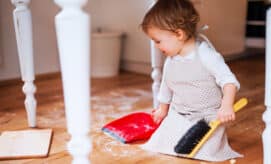When children transition out of our care and into kindergarten, one of our biggest hopes is that they feel happy, capable, and confident in their abilities to try things that are difficult. This week we share a project you can use in your classroom to help children develop life skills, like healthy self-esteem and a positive sense of identity, that will serve them well in kindergarten and beyond.
Collecting Memories with “Joy Jars”
A “joy jar” is a jar that is kept in a prominent place in your classroom for collecting notes, drawings, or photographs of children’s positive experiences. These containers go by many other names, such as Accomplishment Jar, Gratitude Jar, Jar of Awesome, Jar of Success, and Celebration Jar. Any name you like will work, as long as the jar is used frequently for positive reinforcement.
One benefit of including a memory jar in your curriculum is that it provides a concrete way to represent abstract ideas. The jar is a physical representation of children’s happy thoughts, feelings, and memories. When children revisit items that they previously added to the jar, it will help them to remember and reflect upon the positive emotions they felt when the experience took place. These might be a sense of pride, happiness, thankfulness, or even humor.
The jars can focus on a variety of ideas, including…
-
Gratitude: Children write down, draw, or share photos of people, experiences, and things they are grateful for. There is nothing too big or too small to add to a Gratitude Jar.
-
Accomplishments: Different from general gratitude, this topic refers specifically to things that children are proud of themselves for accomplishing or trying. Similar to the jar above, there is no accomplishment too big or too small to include. These can include tasks that children successfully completed, acts of kindness, or even something new that they tried.
-
Happiness: Children share things that made them happy throughout the day. These could be activities they enjoyed, time spent with family or friends, or maybe even a funny memory that made them laugh.
-
Kindness: Children can reflect upon acts of kindness that they experienced, which might be things they did, things someone did for them, or even something they observed.
Helpful Tips
How to Write the Notes
The jar and jar contents can be tailored to the ages of the children contributing to it.
-
If you work with older children, encouraging them to write their own notes to add to the jar offers a great opportunity to practice their writing skills.
-
Younger children might be able to draw a picture of their experience, with the help of a teacher to write a caption or note at the bottom.
-
The very youngest children can be encouraged to share their memory verbally but will require assistance getting it onto paper.
How to add the Jar to your Curriculum
For these jars to be meaningful, they will need to be revisited often. This will allow children to have lots of opportunities to reflect and to add new ideas. A few ideas for planning and incorporating this practice…
-
Set aside a consistent time to add the jar into your schedule. This could be once or twice a week, maybe on Monday for children to reflect and share about their weekend experiences or on Fridays for children to think about the week. It is a good idea to schedule a specific time in the daily schedule, such as during morning meetings or before naps. While children can add ideas to the jar at any time, the scheduled time will allow opportunities for more thoughtful conversations and reflection.
-
Keep the jar in a prominent but safe place. If possible, it will be best to use a plastic jar. If you choose to use one that is glass, you’ll want to be cautious about where it is kept. It should be in a place that is accessible for children to see it, but not a place where it might get knocked over or broken during play.
-
Include parents. Let the parents know what the jar is for by displaying a note next to it, or by sending a photo to families with a brief description of the activity. Parents might be interested in trying something at home and they might be curious to hear what kinds of experiences their children had to contribute.
-
Make it special. Because the jars hold special memories, make the outside feel special too, by putting a ribbon or nice label on the outside. This will also help children to remember that the jar should be treated with thoughtfulness and respect. To help you make your jar look extra special, we created a few different labels that you might be interested in using. Just click on your favorite label to print, and wrap it around the outside of your jar!











